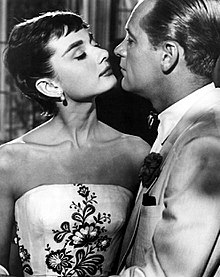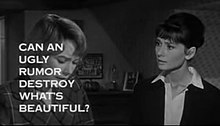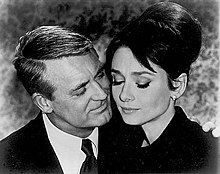Roman Holiday and increased popularity
 In the Italian-set Roman Holiday (1953), Hepburn had her first starring role as Princess Ann, an incognito European princess who, escaping the reins of royalty, falls in love with an American newsman (Gregory Peck). While producers initially wanted Elizabeth Taylor for the role, director William Wyler was so impressed by Hepburn's screen testthat he cast her in the lead. Wyler later commented, "She had everything I was looking for: charm, innocence, and talent. She also was very funny. She was absolutely enchanting and we said, 'That's the girl!'"[44]
In the Italian-set Roman Holiday (1953), Hepburn had her first starring role as Princess Ann, an incognito European princess who, escaping the reins of royalty, falls in love with an American newsman (Gregory Peck). While producers initially wanted Elizabeth Taylor for the role, director William Wyler was so impressed by Hepburn's screen testthat he cast her in the lead. Wyler later commented, "She had everything I was looking for: charm, innocence, and talent. She also was very funny. She was absolutely enchanting and we said, 'That's the girl!'"[44]Originally, the film was to have had only Gregory Peck's name above its title, with "Introducing Audrey Hepburn" beneath in smaller font. However, Peck suggested to Wyler that he elevate her to equal billing so that her name appeared before the title and in type as large as his: "You've got to change that because she'll be a big star and I'll look like a big jerk."[45]
Hepburn garnered critical and commercial acclaim for her portrayal, adding to her unexpected Academy Award for Best Actress with her first BAFTA Award for Best British Actress in a Leading Role and only Golden Globe Award for Best Actress – Motion Picture Drama in 1953. In his review in The New York Times, A. H. Weiler wrote:
'Although she is not precisely a newcomer to films Audrey Hepburn, the British actress who is being starred for the first time as Princess Anne, is a slender, elfin and wistful beauty, alternately regal and childlike in her profound appreciation of newly-found, simple pleasures and love. Although she bravely smiles her acknowledgement of the end of that affair, she remains a pitifully lonely figure facing a stuffy future.'[46]
Hepburn was signed to a seven-picture contract with Paramount with twelve months in between films to allow her time for stage work[47] while spawning what became known as the Audrey Hepburn "look" after her illustration was placed on the 7 September 1953 cover of TIME magazine.[48]
Following her success in Roman Holiday, she starred in Billy Wilder's romantic Cinderella-story comedy Sabrina (1954) in which wealthy brothers (Humphrey Bogart and William Holden) compete for the affections of their chauffeur's innocent daughter (Hepburn). For her performance, she was nominated for the 1954 Academy Award for Best Actress while winning the BAFTA Award for Best Actress in a Leading Role the same year. Bosley Crowther of The New York Times wrote:
'One might guess this is Miss Hepburn's picture, since she has the title role and has come to it trailing her triumphs from last year's "Roman Holiday." And, indeed, she is wonderful in it—a young lady of extraordinary range of sensitive and moving expressions within such a frail and slender frame. She is even more luminous as the daughter and pet of the servants' hall than she was as a princess last year, and no more than that can be said.'[49]
She began another collaboration that year, this time with actor Mel Ferrer, starred in the fantasy play Ondine on Broadway. With her lithe and lean frame, Hepburn made a convincing water spirit named Ondine in this sad story about love found and lost with a human (Ferrer). A New York Times critic commented:
Hepburn received the Golden Globe for World Film Favorite – Female in 1955,[51] but also a major fashion influence. Hepburn was asked to play Anne Frank's counterpart in both the Broadway and film adaptations of Frank's life. Hepburn, however, who was born the same year as Frank, found herself "emotionally incapable" of the task, and at almost thirty years old, too old.[52] The role was eventually given to Susan Strasberg and Millie Perkins in the play and film respectively.
Having become one of Hollywood's most popular box-office attractions, she went on to star in a series of successful films during the remainder of the decade, including her BAFTA- and Golden Globe-nominated role as Natasha Rostova in War and Peace (1956), an adaptation of the Tolstoy novel set during the Napoleonic wars with Henry Fonda and husband Mel Ferrer. In 1957, she exhibited her dancing abilities in her debut musical film Funny Face (1957) where Fred Astaire, a fashion photographer, discovers a beatnik bookstore clerk (Hepburn), who, lured by a free trip to Paris, becomes a beautiful model. The same year Hepburn starred in another romantic comedy, Love in the Afternoon, alongside Gary Cooper and Maurice Chevalier.
She played Sister Luke in The Nun's Story (1959), which focuses on the character's struggle to succeed as a nun alongside co-star Peter Finch. The role accrued her third Academy Award nomination and earned her a second BAFTA Award. A review in Variety said "Hepburn has her most demanding film role, and she gives her finest performance." Films in Review stated that her performance "will forever silence those who have thought her less an actress than a symbol of the sophisticated child/woman. Her portrayal of Sister Luke is one of the great performances of the screen."[53] Reportedly, she spent hours in convents and with members of the Church to bring truth to her portrayal: "I gave more time, energy and thought to this than to any of my previous screen performances."[54]
Following this, she received lukewarm reception for starring with Anthony Perkins in the romantic adventure Green Mansions (1959) where she plays—"with grace and dignity"—the "ethereal" Rima, a jungle girl, who falls in love with a Venezuelan traveler played by Perkins,[55] and The Unforgiven (1960), her only western film, where she appears "a bit too polished, too fragile and civilized among such tough and stubborn types" of Burt Lancaster and Lillian Gish in a story of racism against a group of Native Americans.[56]
Breakfast at Tiffany's and continued stardom[edit]
Three months after the birth of her son, Sean, in 1960, Hepburn began work onBlake Edwards' Breakfast at Tiffany's (1961), a film loosely based on the Truman Capote novella. The film was drastically changed from the original version. Capotedisapproved of many changes and proclaimed that Hepburn was "grossly miscast"[57] as Holly Golightly, a quirky New York call girl,[58] a role he had envisioned for Marilyn Monroe.[57] Hepburn's portrayal of Golightly was adapted from the original: "I can't play a hooker", she admitted to Marty Jurow, co-producer of the film.[57]
Despite the sanitization and resulting lack of sexual innuendo in her character,[57]her portrayal was nominated for the 1961 Academy Award for Best Actress and became an iconic character in American cinema. Often considered her defining role,[59] Hepburn's high fashion style and sophistication as Holly Golightly within the film became synonymous with her. She named the role "the jazziest of my career"[60] yet admitted: "I'm an introvert. Playing the extroverted girl was the hardest thing I ever did."[61] The little black dress which is worn by Hepburn in the beginning of the film is cited as one of the most iconic items of clothing in the history of the twentieth century and perhaps the most famous little black dress of all time.[62][63][64][65]
Playing opposite Shirley MacLaine and James Garner, her next role in William Wyler's lesbian-themed drama The Children's Hour (1961) saw Hepburn and MacLaine play teachers whose lives become troubled after a student accuses them of being lesbians.[59] Due to the social mores of the time, the film and Hepburn's performance went largely unmentioned, both critically and commercially. Bosley Crowther of The New York Times, opined that the film "is not too well acted" with the exception of Hepburn who "gives the impression of being sensitive and pure" of its "muted theme",[66] while Variety magazine also complimented Hepburn's "soft sensitivity, marvellous projection and emotional understatement" adding that Hepburn and MacLaine "beautifully complement each other."[67]
Her only film with Cary Grant came in the comic thriller Charade (1963). Hepburn, who plays Regina Lampert, finds herself pursued by several men who chase the fortune her murdered husband had stolen. The role earned her third and final competitive BAFTA Award and accrued another Golden Globe nomination though critic Bosley Crowther was less kind: "Hepburn is cheerfully committed to a mood of how-nuts-can-you-be in an obviously comforting assortment of expensive Givenchy costumes."[68] Grant (59 years old at the time), who had previously withdrawn from the starring male lead roles in Roman Holiday and Sabrina, was sensitive about the age difference between Hepburn (at age 34) and him, making him uncomfortable about the romantic interplay. To satisfy his concerns, the filmmakers agreed to change the screenplay so that Hepburn's character would be the one to romantically pursue his.[69] Grant, however, loved to humour Hepburn and once said, "All I want for Christmas is another picture with Audrey Hepburn."[70]
Paris When It Sizzles (1964) reteamed Hepburn with William Holden nearly ten years after Sabrina. The Parisian-setscrewball comedy, called "marshmallow-weight hokum",[71] was "uniformly panned"[72] but critics were kind to Hepburn's creation of Gabrielle Simpson, the young assistant of a Hollywood screenwriter (Holden) who aids his writer's block by acting out his fantasies of possible plots, describing her as "a refreshingly individual creature in an era of the exaggerated curve."[71] Critical reception was worsened by a number of problems that plagued the set behind the scenes. Holden tried, without success, to rekindle a romance with the now-married actress; that, combined with his alcoholism made the situation a challenge. Hepburn, after principal photography began, demanded the dismissal of cinematographer Claude Renoir after seeing what she felt were unflattering dailies.[72] Superstitious, she also insisted on dressing room 55 because that was her lucky number (she had dressing room 55 for Roman Holiday and Breakfast at Tiffany's) and required that Givenchy, her long-time designer, be given a credit in the film for her perfume.[72]
"Not since Gone with the Wind has a motion picture created such universal excitement asMy Fair Lady," wrote Soundstage magazine in 1964,[50] yet Hepburn's landing the role ofCockney flower girl Eliza Doolittle in the 1964 George Cukor film adaptation of the stage musical sparked controversy. Julie Andrews, who had originated the role in the stage show, had not been offered the part because producer Jack Warner thought Hepburn or Elizabeth Taylor more "bankable" propositions.[73] Initially refusing, Hepburn asked Warner to give it to Andrews but, eventually, Hepburn was cast.[73]
Further friction was created when, although non-singer Hepburn had sung with "throaty charm" in Funny Face and had lengthy vocal preparation for the role in My Fair Lady,[73]her vocals were dubbed by Marni Nixon.[74][75] A dubber was required because Eliza Doolittle's songs were not transposed down to accommodate Hepburn's "low-mezzo voice" (as Nixon referred to it).[73] Upset, when first informed, she walked out. She returned the next day and apologised to everybody for her "wicked behaviour".[73] Although Hepburn hadlip synced to her recorded tracks during filming, Nixon looped her vocals in post-production and was given multiple attempts to match Hepburn's lip movements precisely.[73]
Overall, about 90% of her singing was dubbed despite being promised that most of her vocals would be used.[73] Hepburn's voice remains in one line in "I Could Have Danced All Night", in the first verse of "Just You Wait", and in the entirety of its reprise in addition to sing-talking in parts of "The Rain in Spain" in the finished film.[73] When asked about the dubbing of an actress with such distinctive vocal tones, Hepburn frowned and said, "You could tell, couldn't you? And there was Rex, recording all his songs as he acted ... next time —" She bit her lip to prevent her saying more.[61] She later admitted that she would have never accepted the role knowing that Warner intended to have nearly all of her singing dubbed.[73]
The controversy reached its height when, despite the film's accumulation of eight out of a possible twelve awards at the 37th Academy Awards, Hepburn was left nomination-less in the Best Actress category. Andrews would be nominated for her efforts in Mary Poppins (1964), and win. The media tried to play up a rivalry between the two women, although both denied any such thing, and got along well. Despite such strife, many critics greatly applauded Hepburn's "exquisite" performance.[75] "The happiest thing about [My Fair Lady]", wrote Bosley Crowther in The New York Times "is that Audrey Hepburn superbly justifies the decision of Jack Warner to get her to play the title role."[74] Her co-star Rex Harrison, who played Professor Higgins, also called Hepburn his favourite leading lady and Gene Ringgold of Soundstage also commented that "Audrey Hepburn is magnificent. She is Eliza for the ages,"[50] while adding, "Everyone agreed that if Julie Andrews was not to be in the film, Audrey Hepburn was the perfect choice."[50]
As the decade carried on, Hepburn appeared in an assortment of genres including the heist comedy How to Steal a Million(1966) where she played Nicole, the daughter of a famous art collector whose collection consists entirely of forgeries. Fearing her father's exposure, Nicole sets out to steal one of his priceless statues with the help of Simon Dermott (Peter O'Toole). In 1967, she starred in two films; the first being Two for the Road, a non-linear and innovative British dramedy that traces the course of a couple's troubled marriage. Director Stanley Donen said that Hepburn was more free and happy than he had ever seen her, and he credited that to co-star Albert Finney.[76]
The second, Wait Until Dark, is a suspense thriller in which Hepburn demonstrated her acting range by playing the part of a terrorised blind woman. Filmed on the brink of divorce, it was a difficult film considering husband Mel Ferrer was its producer and she lost fifteen pounds under the stress, but she found solace in co-star Richard Crenna and director Terence Young. Hepburn earned her fifth and final competitive Academy Award nomination for Best Actress; Bosley Crowther affirmed, "Hepburn plays the poignant role, the quickness with which she changes and the skill with which she manifests terror attract sympathy and anxiety to her and give her genuine solidity in the final scenes








0 comments:
Post a Comment